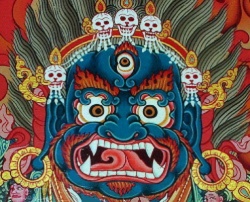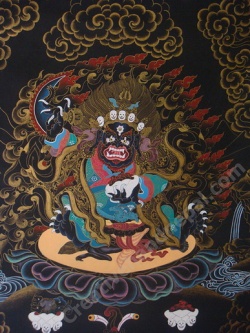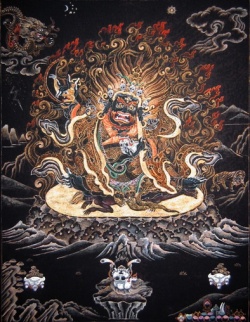Symbolism of Mahakala in the 6-armed Manifestation:
The Protector's body is midnight blue, symbolic of the changeless Dharmakaya.
His three eyes symbolize his knowledge of the past, present and future, and also the manifestation of the three bodies of Buddha.
The crown adorned with five skulls symbolizes the transformation of the five poisons of anger, desire, ignorance, jealousy and pride into the five wisdoms.
His six arms symbolize the attainment of the six Perfections: generosity, patience, morality, diligence, meditation and wisdom.
The kartika or triku [or trigu, pron. tigu the ritual curved knife, cuts attachment to ego.
The kapila or skull bowl filled with blood symbolizes the subjugation of the maras or evil ones. (An alternate interpretation can be found in other contexts.)
The rosary symbolizes his continuous activity for the benefit of beings.
The damaru or hand-drum symbolizes his power over the dakinis. (Also, different interpretations in other contexts.)
His trident symbolizes his power over the three kayas -- the spheres of desire, form and formlessness. (An alternate interpretation can also be found.) The lasso binds those who break their vows.
His two feet are the means and the wisdom to accomplish his task. That his left leg is straight and his right leg bent symbolize his accomplishment of the benefit to oneself and to others. He tramples on a vinayaka, to symbolize his destruction and dispersal of great obstacles.
The sun on which he stands symbolizes his illumination of the darkness of ignorance.
His lotus seat symbolizes purity undefiled by samsara. The surrounding blazing fire symbolizes his activity that consumes neurotic states. The tiger skin stands for purification of desire; the elephant skin for purification of pride, and the snake, for the purification of anger. His other ornaments together symbolize that he has all the qualities of a Buddha.
This material derives from a Gelugpa sadhana (ritual) of Tara that includes an offering to Mahakala.
Six-armed (Shadbhuja) Mahakala is an incarnation of Avalokitesvara. This form is most favored by the Gelukpa order of Tibetan Buddhism, and in this manifestation Mahakala is considered to be the fierce and powerful emanation of Avalokiteshvara, the bodhisattva of compassion.
Mahākāla (Sanskrit) is a Dharmapala ("protector of dharma") in Vajrayana Buddhism, and a deity in Chinese and Japanese Buddhism, particularly in the Vajrayana school. He is known as Daheitian (大黑天) in Chinese and Daikokuten (大黒天) in Japanese. Mahākāla belongs to the fourth hierarchy of deities. In Hinduism, Mahakala is a name of Shiva.
Mahākāla is relied upon in all schools of Tibetan Buddhism. However, he is depicted in a number of variations, each with distinctly different qualities and aspects. He is also regarded as the emanation of different beings in different cases, namely Avalokiteshvara (Tib: spyan ras gzigs) or Chakrasamvara (Tib: Korlo Demchog, Wylie: ’khor lo bde mchog).
Mahākāla is typically black in color. Just as all colors are absorbed and dissolved into black, all names and forms are said to melt into those of Mahakala, symbolizing his all-embracing, comprehensive nature. Black can also represent the total absence of color, and again in this case it signifies the nature of Mahakala as ultimate or absolute reality. This principle is known in Sanskrit as "nirguna", beyond all quality and form, and it is typified by both interpretations. There is also a White Six-Armed Mahakala (Skt: Shad-bhuja Sita Mahakala; Tib. Wylie: mGon po yid bzhin nor bu) popular among Mongolian Gelugpas.
Mahākāla is almost always depicted with a crown of five skulls, which represent the transmutation of the five kleshas (negative afflictions) into the five wisdoms. The most notable variation in Mahākāla's manifestations and depictions is in the number of arms, but other details can vary as well. For instance, in some cases there are Mahakalas in white, with multiple heads, without genitals, standing on varying numbers of various things, holding various implements, with alternative adornments, and so on. [[[Wiki]]]


